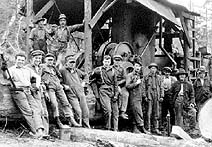

|
|
Life As a Logger Photo:
Courtesy of British Columbia Archives, Province of British Columbia
(www.bcarchives.gov.bc.ca). Call #D-04832. In the early 1900s lumber
companies needed large crews of men who would work 12- to 14-hour-days at a forest site
that was often far from the nearest town. It became necessary for the companies to set up
"lumber camps," which provided a place for the workers to eat and sleep after
each arduous day of labor. For the most part, the sleeping quarters were dark, dank,
foul-smelling places. In cold weather, pot-bellied stoves in makeshift cabins provided
heat, but ventilation was poor, and damp clothing and laundry rarely dried in time for the
next workday. The few historical photographs from this era do not paint a pretty picture
of these places of rest. Photo:
Courtesy of British Columbia Archives, Province of British Columbia
(www.bcarchives.gov.bc.ca). Call #D-04832. In the early 1900s lumber
companies needed large crews of men who would work 12- to 14-hour-days at a forest site
that was often far from the nearest town. It became necessary for the companies to set up
"lumber camps," which provided a place for the workers to eat and sleep after
each arduous day of labor. For the most part, the sleeping quarters were dark, dank,
foul-smelling places. In cold weather, pot-bellied stoves in makeshift cabins provided
heat, but ventilation was poor, and damp clothing and laundry rarely dried in time for the
next workday. The few historical photographs from this era do not paint a pretty picture
of these places of rest.
Once in a while, workers arrived at camps with a family in tow. According to some historical documents and images, families might wind up living in a tent with some rough boards out front to lessen the amount of mud brought into the living space. Cooking would likely have been done in a separate canvas-covered area next to the tent. But these people were not on vacation in Yosemite Park; they were living in a rainforest. What would young children do with their day when it rained--for twelve days in a row? How do you imagine the mother would spend her day? How would she keep her children clean and healthy? Would that even have been possible under these conditions? Look closely at the image of this lumber camp. It is very typical of the camps in the rainforests of the Northwest in the early 1900s. Imagine yourself in a tent at the far edge of the workers quarters. You can be a child, a teenager, a newly married parent or a logger who has just brought his family out to the lumber camp from town. You may have migrated here to find work, any work. Put yourself in the picture. From what you can see, and other things that you've learned in this module, develop a story. What would it be like to live here? The Loggers Memorial in Forks, Washington [ Views of the Forest ] [ Timber Industry ] [ Home ] [ Teacher Pages ] [ Modules & Activities ] |
HTML code by Chris Kreger
Maintained by ETE Team
Last updated November 10, 2004
Some images © 2004 www.clipart.com
Privacy Statement and Copyright © 1997-2004 by Wheeling Jesuit University/NASA-supported Classroom of the Future. All rights reserved.
Center for Educational Technologies, Circuit Board/Apple graphic logo, and COTF Classroom of the Future logo are registered trademarks of Wheeling Jesuit University.